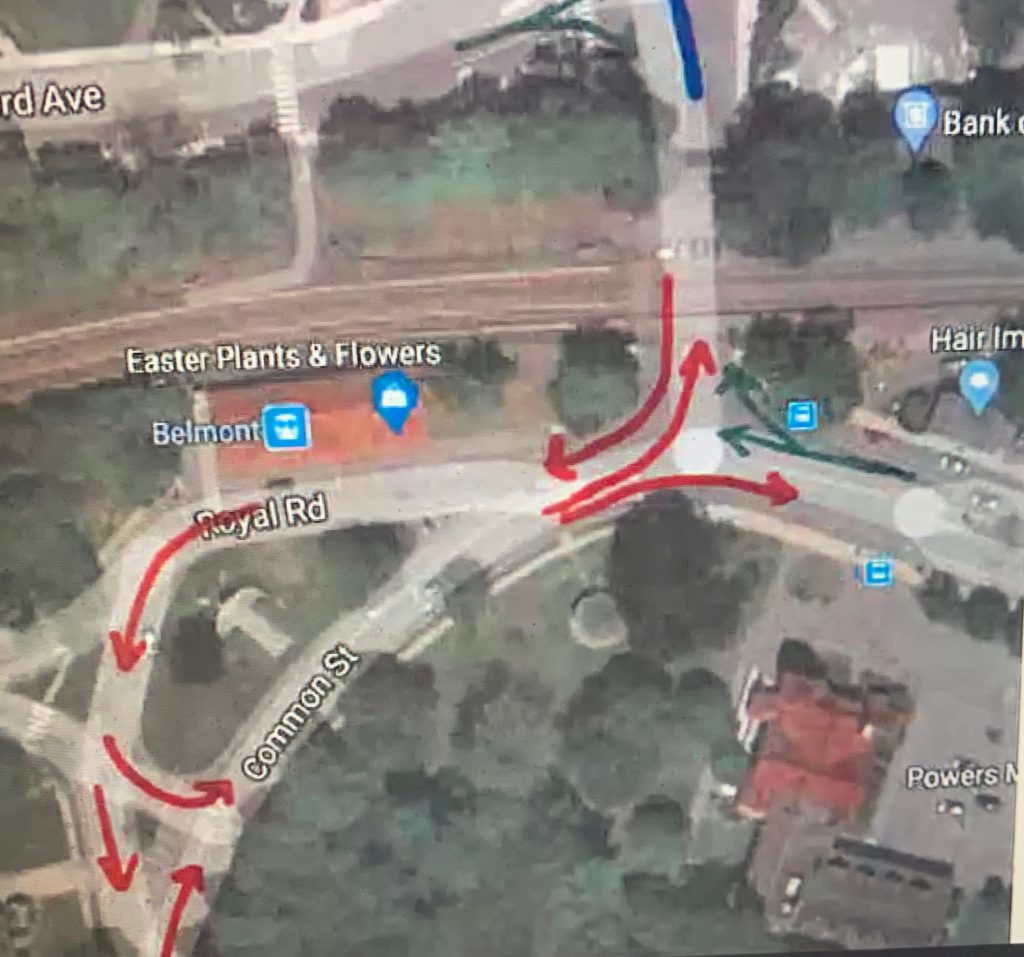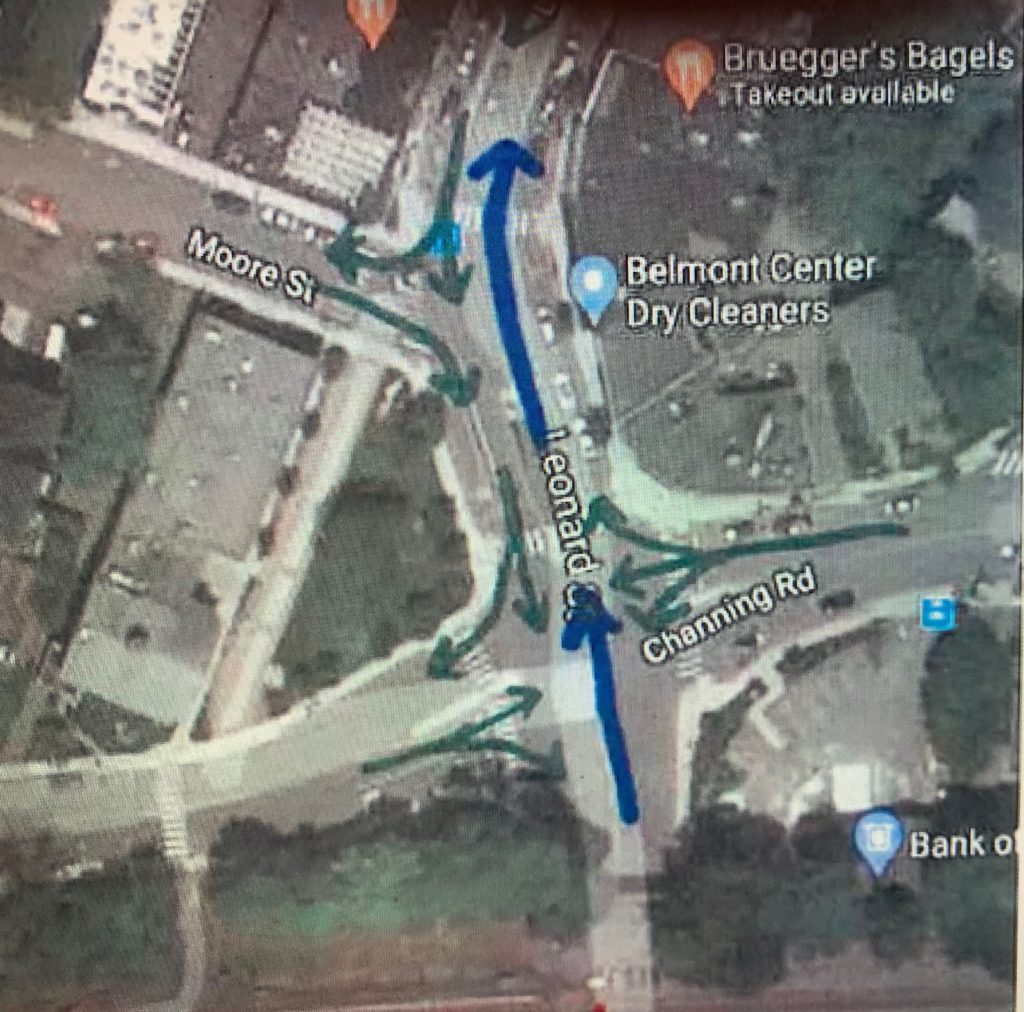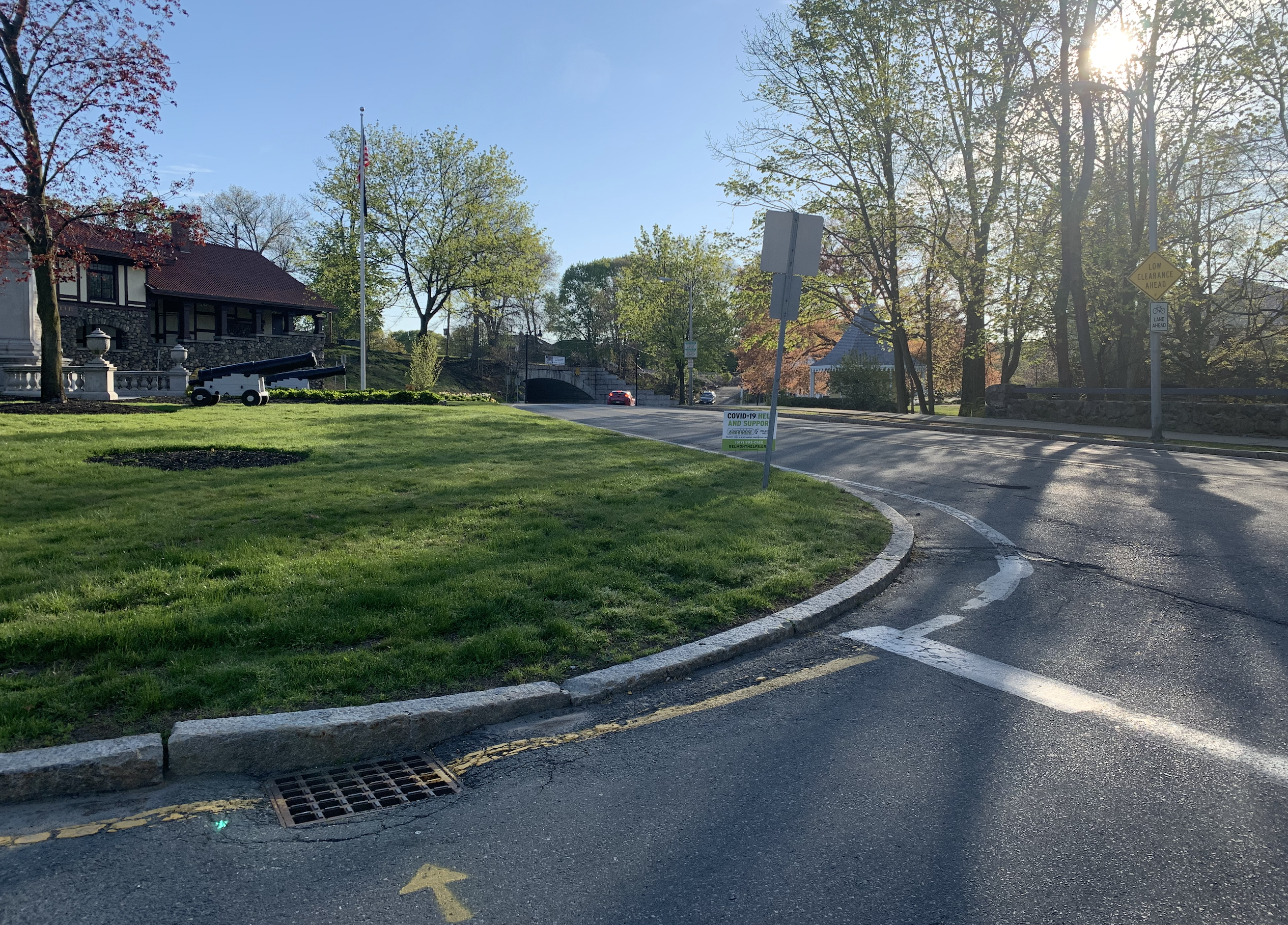Photo: The WWI Memorial will become the new way to get onto Concord Avenue westbound from Belmont Center during an experiment to make the intersection with Common Street safer.
Whenever Glenn Clancy thinks Town Administrator Patrice Garvin needs cheering up, he will throw out something “crazy out there” at a meeting or in an email.
“I would talk about, like, my dreams for Belmont Center,” said Clancy, the town’s long-time director of the Office of Community Development as well as the town engineer. Those flights of fancy encompass a design – he is an engineer, after all – that will ease the daily bottleneck of commuters hammering through Belmont’s main business district by sending drivers looping around the center in creative new ways.
Then, last month, Garvin told Clancy that now would a great time to follow that dream.
Last Monday, Clancy received the initial go-ahead from the Belmont Select Board to try out one of a pair of ideas that will require drivers to begin looping around Belmont Center in the name of efficiency and safety.
“My real goal tonight is to have the board … maybe not necessarily say ‘Yes, it’s crazy enough that it might work,’ but say ‘Glenn, it’s crazy enough that we feel comfortable with you kind of taking it to the next step and continuing to do your homework here,” said Clancy.
It will all start with the town putting its foot down on left-hand turns.
“I have always been troubled by the left turn conflicts that are created at that intersection of Common Street and Concord Avenue,” said Clancy. A great amount of southbound traffic coming out of the tunnel wants to turn left onto Concord Avenue westbound towards Cambridge. At the same time, there is a good amount of southbound traffic on Common Street looking to take a left under the bridge entering the Center.
“And so you have these two left-turning movements that are in conflict with each other and with each other and they are creating queuing that is impacting the flow of traffic through Belmont Center,” said Clancy. It’s little wonder that this intersection has one of the highest numbers of fender benders in town.
This is not a new problem. A decade previously, the BSC Group, the Boston-based engineering firm that has been Belmont’s go-to for traffic studies, was looking “at a whole host of ways to manage traffic on either side of the bridge,” said Clancy.
“One of the ideas they threw out there was, ‘Hey, what if we turn the Memorial Island into a roundabout and make everybody come up off the bridge?'” said Clancy. The problem with that proposal meant redesigning the island and its near century-old monument for those residents killed in WWI.
“It would have impacted the Lions Club (located at the Belmont commuter rail station) in the activities that they’re involved with over there would have completely changed the landscape of the memorial island itself,” said Clancy.
“I didn’t have an appetite for that,” he confessed.
The perfect time to experiment
Just as that plan was set aside, an explosion of commuters from Arlington and points west began using Belmont Center as a cut though rather than battle with the gridlock at the Route 2/Alewife Station/Fresh Pond interchanges in Cambridge. With the center’s traffic becoming “so unmanageable,” Clancy put the idea to bed for the next 10 years.
Move forward a decade and due to the COVID-19 pandemic and the resulting stay at home edict passed by Gov. Charlie Baker in mid-March, the traffic levels in Belmont today now resembles what the town sees on a hot Sunday afternoon in August – over 50 percent of the norm.
With traffic levels in Belmont greatly reduced, Garvin told Clancy now would be an opportune time to move forward with a trial balloon on easing traffic through town. “[W]e have a town-wide traffic study that’s informing us on where that traffic’s coming from where they’re trying to get to,” said Clancy.
Rather than attempting to reinvent the wheel, “I thought, ‘Geez, you know, maybe we should try to utilize the existing layout of the roadway’,” said Clancy, keeping the memorial as it is.
The main “experiment” would go back to solving the competing lefts by restricting vehicles from taking the left turn onto Concord Avenue eastbound towards Cambridge. Those looking to travel points east towards the high school or Cambridge would be directed to loop around the WWI Memorial where drivers would then proceed to take the left onto Common Street. (follow the red arrows on the illustration) And, voila! An end to the dueling left-hand turns.

“It’s that simple,” said Clancy. The experiment would last for two to three weeks to determine its impact and effectiveness. “I see us doing it long enough for us to determine whether or not it’s going to work.”
Clancy told the board he would wait until the state begins lifting the stay-in-place restriction on non-essential businesses to better resemble what a typical traffic flow will be. He said the proposal will be studied first by the BSC Group to see if there are “any fatal flaws” in the plan.
What Clancy is aware of is that some residents will see his dream as their nightmare. “I acknowledged that there’s going to be inconvenienced for people to always have to take that right.”
“If this works and this becomes a long term solution, at 11 o’clock in the morning, when you’re going under that bridge and you’ve got all that wide-open terrain in front of you and you’re forced to take a ride and go all around the world to get back to where you want to go, people are not going to be happy,” said Clancy.
But Clancy countered his own observation by stating the vast majority of peak hours traffic is from out of town, commuter traffic.
“They are the ones impacting the quality of life in the town. And there are going to have to be sacrifices made with the residents of the town to mitigate the impacts of the traffic that is coming in going through Belmont, through no fault of the residents who live here,” he said.
The second proposal would be a second looped detour, prohibit left turns onto Concord Avenue towards Town Hall and Pleasant Street after entering Belmont Center from the tunnel. (see blue arrows).
Cutting the queue
Drivers wishing to continue on Concord Avenue westbound towards Lexington and McLean Hospital would be required to travel up Leonard Street to the lights and take the left on Pleasant to reach Concord Avenue. Clancy said this restriction would only be needed for a couple of hours (suggested times: 8 a.m. to 9:30 a.m. and 4 p.m. to 6 p.m.) during the morning and evening commutes.

“What that does is it eliminates any of the bottlenecking that’s occurring right now at the Leonard/Channing/Concord intersection,” said Clancy. The current gridlock can result in traffic backed up on Concord Avenue all the way to Underwood Street adjacent to Clay Pit Pond.
Clancy told the board he’s eager to find a way to unplug the congestion in Belmont Center because a traffic signal will be installed at the intersection of Goden Street and Concord Avenue as part of the new Belmont Middle and High School project. And as it stands now, “that signal is not going to allow a lot of traffic to release off of Goden Street because the queue on Concord is going to be so unmanageable.”
“This is really an effort to try to look not only at the way traffic is flowing in and around Belmont Center but also take an opportunity here to see if we can alleviate the backup that’s occurring on Concord Avenue westbound in the evening,” he said.
While Select Board member Adam Dash dubbed the first plan “brilliant,” he was concerned that halting the left onto Concord Avenue after the tunnel would require anywhere from 30 to 45 minutes to navigate the “loop” to return to Concord Avenue. Clancy said he will see if the lights at the intersection of Leonard and Pleasant has the ability to manage additional traffic and if a dedicated “left” lane can be added on Leonard Street.
Garvin advised the board that the town will have a limited window of opportunity to introduce a new traffic pattern to residents and commuters as traffic begins to “ramp back up.”
“What we’re doing trying to do is gather some information to then bring to the public to see if it worked,” said Garvin.
Both Dash and member Tom Caputo did feel that public input through the Transportation Advisory Committee should be sought but were satisfied that the “experiment” was temporary and there would be public meetings on the result.
With the board’s thumbs up to move forward on the first plan, Clancy will begin meeting with Belmont Police and Public Works on a traffic management proposal that will include the locations of barrels and barriers and where police officers would be stationed.
“And if successful, this will be a full-time change to the traffic pattern coming out of Belmont Center,” said Clancy.








This is simply a bad idea that will only make matters worse. It is definitely a problem traffic area but this “ solution “ is just moving the problem or most likely adding additional problems. Good drivers know how to navigate the current situation and shouldn’t be inconvenienced further . Poor drivers will still be poor drivers and this will alleviate nothing .. One of the reasons living in Belmont is expensive is the proximity to the city . We are not outside 495 . City access equals traffic, get over it .
Thanks
Trying to understand the logic behind hurrying to test the concepts worthiness with a traffic study that doesn’t take normal traffic patterns into consideration. Then make those changes permanent without any true or realistic idea as to how they will affect the bottlenecks future.
I would think a real test would be two weeks with normal traffic patterns. Only then can anyone gauge what impact these changes will truly have.
I live in Arlington and work near fresh pond. Deal with that intersection all the time. It looks like the proposal is to treat it as a ‘jug handle left’. That’s the way Nashua NH labels a similar one in front of their Whole Foods.